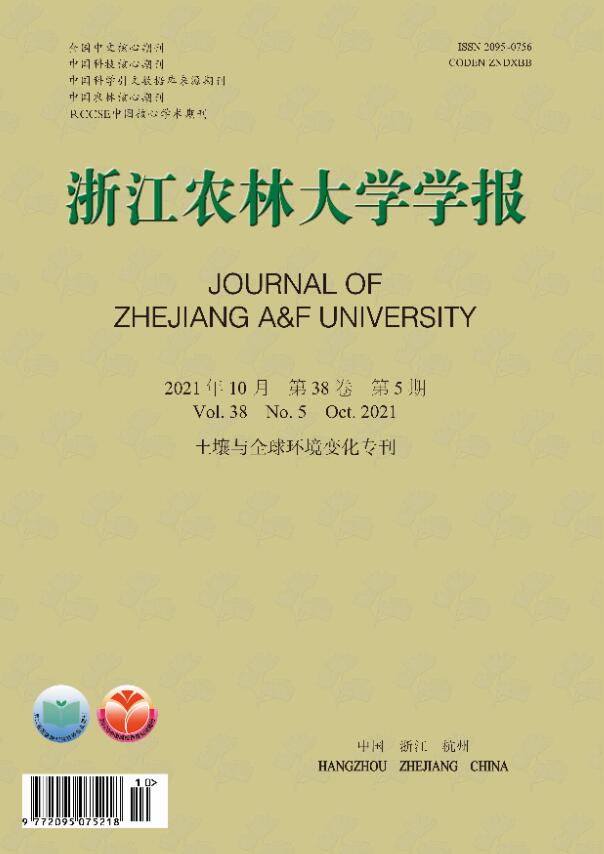-
在陆地生态系统中,碳汇功能体现在碳库的贮量和积累速率,而碳源则体现在碳的排放强度。全球约1 400~1 500 Gt碳以有机态储存于土壤中,是陆地植被碳库(500~600 Gt)的2~3倍,是全球大气碳库(750 Gt)的2倍多。在陆地生态系统中,森林是最大的有机碳储存库,占整个陆地生态系统碳储量的56%[1]。森林土壤有机碳(SOC)主要分布于土层1 m深度以内,碳总储量为1 220 Pg,约占陆地土壤碳库的40%[2]。土壤碳库的稳定、增长或衰减都与大气二氧化碳(CO2)变化密切相关。据推测,在2 m土层中的土壤有机质质量分数增加5%~15%可减少大气中16%~30% CO2[3]。因此,增加土壤碳库和保持土壤碳库的稳定性对缓解全球变暖趋势具有同样重要意义。土壤微生物是养分和土壤有机质动态的主要调控者。作为森林生态系统的重要组成部分,土壤微生物参与了有机物分解和土壤物质转化过程,其种类组成与活性直接影响森林物质循环和养分供应[4]。土壤微生物是构成土壤肥力的重要因素,在维持土壤质量中起着重要作用。土壤微生物还具有固碳机制:生物体死亡后形成难以降解的碳源物质(如木质素、几丁质等),及土壤微生物通过提高其活性加快有机质的分解来积累有机碳[5]。土壤微生物的生物量、活性、群落组成都直接影响着土壤碳的固存及周转过程,土壤碳储量的大小与其密切相关。因而,开展土壤微生物及相关指标的研究对理解森林土壤有机碳的碳库动态与特征具有重要意义。杉木Cunninghamia lanceolata是中国特有的优良速生针叶用材树种,在中国森林系统中占据了重要地位。杉木栽培遍及中国亚热带多个省(自治区),栽培面积约17×106 hm2[6]。杉木林不仅提供了大量的商品用材[7-8],在固碳、涵养水源等生态功能方面也发挥了巨大的作用[9]。土壤质量下降已成为杉木人工林可持续经营的主要障碍,而生物多样性减少以及林地凋落物质量下降是导致土壤质量退化的重要原因。多代连栽杉木人工林出现了地力衰退、微生物多样性及数量下降、林分生产力下降等生态问题[10-11]。土壤有机碳和微生物特征是表征土壤质量的2个最重要指标,而且两者之间的关系又极其密切[12-13]。近年来,随着森林土壤有机碳在碳封存过程中被日益重视,以及高通量测序技术在土壤微生物研究中的广泛应用,杉木林土壤有机碳和微生物特征的研究取得了很多重要的进展。鉴于此,本研究对杉木林土壤有机碳和微生物群落特征及其影响因素的研究进展进行综述,为提高杉木林地生产力,增强杉木林生态系统的碳封存潜力,探究杉木人工林的连作障碍提供理论依据。
HTML
-
森林土壤有机碳是土壤有机碳库中的重要组成部分,而土壤有机碳能显著影响土壤微生物的多样性和功能[13]。根据微生物的可利用程度,土壤有机碳库分为易分解有机碳、难分解有机碳和惰性有机碳。易分解有机碳有较高的生物利用率与损失率,难分解有机碳则有较高的残留率,一般占土壤有机质的60%~80%。
在森林生态系统中,土壤有机碳储量是反映土壤有机物质的输入与损失之间平衡的指标[14]。碳汇功能主要体现在碳的储量、积累率、有机碳活性及稳定性等4个方面。由于在土壤物理化学和生物学特性中发挥着极其重要的作用,土壤有机碳被认为是土壤质量的重要指标。对于森林生态系统来说,土壤有机碳不仅是评价土壤质量和土地可持续利用的重要指标,也是评估CO2固定能力的重要指标[15-16]。
人工林土壤有机碳受到多种因素的影响,其动态变化过程和稳定机制具有一定的特殊性。杉木人工林生态系统中的储量取决于气候条件、植被组成、林分年龄以及林分分布区域、立地条件、林分密度、人类干扰、施肥、林分管理等因素。刘曦乔[17]研究显示:优势树种、坡位、龄组、海拔、灌木覆盖度与土壤有机碳密度呈极显著正相关(P<0.01),凋落物层碳密度与土壤碳密度呈显著正相关(P<0.05)。
不同的地理区域造成了气候条件、立地条件、土壤类型等方面的差异。广西省杉木人工林土壤平均碳储量为67.33 t·hm−2[18],浙江省杭州市临安区杉木人工林的土壤碳储量为16.10 t·hm−2[19]。在区域地理差异较小的林分之间,土壤碳库特征也存在一定差异,如福建省永安杉木人工林的土壤有机碳储量和密度较福建建阳杉木人工林高[20]。
-
杉木人工林土壤有机碳含量、碳储量均随着林龄的增大呈先降低后增加的趋势,以54 a杉木林土壤碳储量最大[17, 21],但江西大岗山杉木人工林最大土壤碳储量却出现在5 a幼龄林,各林龄0~40 cm土层有机碳储量从大到小依次为5 a幼龄林(85.38 t·hm−2)、50 a过熟林(79.77 t·hm−2)、32 a成熟林(71.62 t·hm−2)、15 a中龄林(62.30 t·hm−2)、25 a近熟林(60.97 t·hm−2)[22]。
-
林分管理可以分为以下几方面:①林分类型与转换。亚热带地区常绿阔叶林向杉木人工林的转换早期导致土壤碳释放,但长期对土壤碳储量没有影响。延长轮作周期将抵消森林转化对土壤碳储量的不利影响[23]。天然次生林转变为杉木人工林后,不仅导致有机碳储量减少,而且土壤有机碳含量和土壤碳库管理指数也随之下降[24]。②杉木与固氮树种混栽。杉木与固氮树种(台湾桤木Alnus formosana、大叶相思Acacia auriculaeformis、杨梅Myrica rubra和刺槐Robinia pseudoacacia)的混栽模式,可有效提高根际区和非根际区的土壤有机质含量,从而提高混栽模式的土壤有机碳储量[25]。③皆伐与间伐。皆伐通过改变土壤温度、含水量、有机碳来源等因素导致森林土壤有机碳含量下降,而间伐通过改进森林的环境而影响其生长和碳储量。间伐对土壤有机碳的影响则与间伐强度有关,杉木人工幼龄林的合理间伐强度为40%~50%[26-27]。④残余物保留。凋落物对土壤有机碳的影响取决于凋落物自身的特性和土壤条件。凋落物厚度与土壤含水量是影响有机碳储量的主导因子。增加凋落物输入量促进了土壤中有机碳的积累,但另一方面也会因输入更多的新鲜可溶性有机质而加速土壤中有机碳的分解,从而导致土壤有机碳含量的下降。林下残余物保留可显著提高土壤有机碳及各组分的含量[28]:0~10 cm土层土壤有机碳含量,林下残余物保留处理(24.74 g·kg−1)显著高于清除(13.43 g·kg−1)和火烧(20.14 g·kg−1)(P<0.05)。阮超越等[29]认为:添加凋落物对土壤碳的影响不明显。相比土壤氮而言,土壤有机碳本身的背景值较大,短期的控制试验很难对土壤有机碳产生显著影响。⑤林分密度。土壤有机碳储量随杉木造林密度的增加而增加,但密度超过3 333株·hm−2后趋于稳定。根据立地条件的不同,杉木人工林适宜的造林密度应为2 500~3 333株·hm−2[30]。⑥火烧。火烧导致土壤有机碳的释放,其影响取决于火烧后恢复时间、火烧温度、火烧强度、土层深度等[26]。⑦施肥。施用有机肥、有机无机肥配施、生物质炭添加及覆盖均可提高土壤有机碳含量和储量[26]。目前中国东南部杉木林的氮沉降水平(5~10 kg·hm−2·a−1)对碳封存的贡献为7.4×106 Mg·a−1。如果氮沉降增加到7.5~15.0 kg·hm−2·a−1,碳封存则可达16.0×106 Mg·a−1[31]。
原材料和制备温度是生物质炭影响土壤原有有机碳矿化和生物质炭分解的重要因素。尹艳等[32]利用13C标记技术研究不同热解温度制备的生物质炭添加对杉木人工林土壤原有有机碳矿化影响的研究表明:培养结束时,杉木和木荷Schima superba生物质炭处理均显著抑制了土壤原有有机碳矿化(P<0.05)。同一热解温度下,木荷生物质炭的分解率显著高于杉木生物质炭(P<0.05)。
-
海拔通过影响区域气候、森林土壤理化性质、植被分布,以及因植被密度不同对土壤碳汇特征产生影响。海拔变化使植被群落呈现有规律的垂直分布,区域气温与降水量及土壤性质均存在显著变化,并使地上凋落物与地下根系及其分泌物的输入发生变化,进而导致土壤碳储量沿海拔空间分布呈显著差异[33]。张莎莎等[34]研究发现:随着海拔的升高,不同土层土壤有机碳含量和储量呈先降低后显著增加的趋势(P<0.05)。
-
土壤活性有机碳是土壤中活跃的化学组分,能显著影响土壤化学物质的溶解、吸附、解吸、吸收、迁移以及生物毒性等行为。活性有机碳更能够表征土壤质量的变化,而且在维持生态功能和养分循环中起着关键作用[35]。
土壤微生物生物量是不稳定的碳库,可作为评价土壤质量的生物指标。水溶性有机碳、微生物生物量碳(MBC)的降低会抑制土壤碳的释放,从而增加土壤碳固定。轻组有机碳(LFOC)、微生物生物量碳、颗粒有机碳(POC)及溶解性有机碳(DOC),均可作为有机碳动态的敏感指标[36]。
林分的植被组成是影响杉木林土壤活性有机碳的重要因素。毛竹Phyllostachys edulis向杉木林扩张有利于土壤质量的提高。徐道炜等[37]研究显示:0~60 cm土层水溶性有机碳和易氧化态碳储量从大到小均为毛竹林、毛竹-杉木混交林、杉木林;3种林分土壤碳库活度和碳库活度指数从大到小依次为杉木林、毛竹-杉木混交林、毛竹林。原位观测结果表明:杉木纯林转换为杉木-阔叶树混交林后,土壤CO2排放通量减少,表现为杉木纯林土壤CO2的排放通量(490 mg·m−2·h−1)高于杉木-栲树Castanopsis fargesii混交林(254 mg·m−2·h−1)和杉木-桤木Alnus cremastogyne混交林(332 mg·m−2·h−1)[38]。
-
杨洋[39]研究表明:去除林下植被显著降低了土壤溶解性有机碳含量和土壤β-1,4-葡萄糖苷酶(βG)活性(P<0.05),而添加凋落物同时保留林下植被则显著增加了土壤含水量和溶解性有机碳,并显著增强了βG和β-1,4-N-乙酰基-葡糖胺糖苷酶(NAG)活性(P<0.05)。不同林分凋落物配比对杉木人工林中土壤微生物生物量碳含量的影响也有显著差异。m(杉木)∶m(火力楠Michelia macclurei)=2∶1和m(杉木)∶m(火力楠)=1∶1的处理显著高于杉木或火力楠凋落物单一配比处理(P<0.05)[40]。
间伐导致土壤温度和湿度增加,促进了土壤微生物和酶活性,加速了凋落物和细根分解,进而增加了土壤活性有机碳含量。因此,间伐后土壤溶解性有机碳、易氧化有机碳(ROC)和轻组有机碳含量随间伐强度增加而增大,但在较长时段内(>15 a),间伐不会影响土壤有机碳中活性有机碳组分的变化[27]。
残余物清除和火烧处理对土壤有机碳的活性指数也有显著影响。残余物清除处理的土壤有机碳活性指数(43.5%)显著高于残余物保留(32.6%)和火烧(36.1%)处理(P<0.05),残余物保留和火烧处理土壤有机碳的难降解指数(67.4%和64.0%)分别为残余物清除处理(56.5%)的1.2和1.1倍,火烧处理的土壤有机碳活性指数最低,难降解指数最高[28]。天然林改为杉木人工林后,土壤有机碳和活性有机碳(LOC)组分的碳密度显著降低(P<0.05),但以轻组有机碳和微生物生物量碳的降幅最大,平均降幅分别为56%和62%[41]。
李艳鹏[42]研究表明:与对照相比,混合施用氮肥和磷肥使土壤水溶性有机碳含量分别降低了24.1%和29.4%,使微生物生物生物量碳含量降低了17.9%(P<0.05)。低水平氮磷添加显著提高0~5 cm土层土壤水溶性有机碳,磷添加使颗粒有机碳与土壤有机碳比值显著降低了15.9%(P<0.05)[43]。
-
土壤总有机碳、水溶性有机碳、易氧化有机碳含量随着林龄增加而呈先降后升的变化趋势,过熟林阶段最高,中龄林阶段最低[21]。张剑等[44]研究表明:土壤总有机碳、微生物生物量碳、活性碳库Ⅰ(LP Ⅰ)、活性碳库Ⅱ(LP Ⅱ)和重组有机碳(HOC)含量以及微生物熵均在中龄林最低,而活性有机碳和顽固性组分(RF),随林龄增加而上升。杉木人工林发育过程中,土壤有机碳稳定性增强[45]。
-
土壤有机碳的稳定性分为生物化学稳定性、化学稳定性和物理稳定性等。封存在团聚体内和吸附在矿物上的土壤有机碳是其物理保护机制[46],如植硅体碳的封存机制是有机无机复合体抗化学溶解的物理保护作用[47]。土壤有机碳的稳定性主要体现在土壤有机碳周转期的长短[48],土壤有机碳的周转率通常用碳稳定状态的平均滞留时间或半衰期来表示。土壤碳稳定性受到磷含量的调控,短期磷添加易导致表层土壤活性有机碳分解,从而增加土壤碳稳定性,相反,氮添加增加土壤有机碳矿化速率,降低土壤碳的稳定性[43]。杉木人工林红壤中约41%~49%的有机碳受到土壤矿物的吸附,矿物吸附表明杉木人工林土壤有机碳具有生物化学稳定性[49]。
-
植硅体是高等植物根系吸收土壤中的可溶性单硅酸(H4SiO4),并在叶片的蒸腾作用下沉淀在植物细胞壁、细胞内腔和细胞壁间而形成的水合物(SiO2·nH2O)。土壤本身并不产生植硅体,植硅体主要是植物残体腐烂分解后释放到土壤表层。在陆地生态系统中,土壤植硅体的储量一般占土壤质量的1%~3%,是其他地表植物生物量中植硅体储量的500~1 000倍[50]。植硅体在植物体内形成过程中,包裹0.1%~6.0%称为植硅体封存态碳的有机碳。虽然植硅体碳占土壤有机碳质量分数仅为0.72%~9.26%,但其周转期要比其他土壤有机碳长2个数量级以上,因而是最稳定的碳。植硅体碳具有很高的抗氧化和抗分解能力,可长期累积于土壤中达数千年至万年之久,因此,在缓解全球气候变暖趋势方面具有重要作用[51-52]。
朱浩宇等[53]对亚热带4种林分土壤植硅体碳含量及储量的比较研究显示:在0~100 cm土层中,不同林分土壤植硅体碳储量从大到小依次为毛竹林(23.45 t·hm−2)、针阔叶混交林(8.19 t·hm−2)、针叶林(5.35 t·hm−2)、阔叶林(3.13 t·hm−2)。5个亚热带林分1 m土层植硅体碳总储量从大到小依次为杉木林(4.025×107 t)、马尾松Pinus massoniana林(2.575×107 t)≈阔叶林(2.542×107 t)、毛竹林(1.988×107 t)、针阔混交林(0.340×107 t)[54]。
综上所述,虽然杉木林土壤植硅体碳储量低于毛竹林,但由于杉木林的种植面积比毛竹林大得多,因此,杉木林的土壤植硅体碳总储量比毛竹林要高得多,可见杉木林在亚热带森林生态系统植硅体碳汇中占有十分重要的地位。
1.1. 杉木人工林土壤有机碳的碳汇特征
1.1.1. 林分地理区域
1.1.2. 林分年龄
1.1.3. 林分管理
1.1.4. 林分海拔高度
1.2. 杉木人工林土壤活性有机碳
1.2.1. 林分植被组成
1.2.2. 林分管理
1.2.3. 林分年龄
1.3. 杉木人工林土壤有机碳的稳定性
1.3.1. 土壤有机碳稳定性机制及评价指标
1.3.2. 植硅体及植硅体碳的形成及其影响因素
-
土壤微生物是森林土壤物质循环和能量流动的直接参与者。微生物功能多样性是维持森林凋落物分解过程中的关键,能较早反映土壤环境质量和养分元素的变化过程以及微生物群落功能差异,可作为敏感性生物指标。土壤微生物在土壤形成和发育、土壤肥力演变、土壤养分循环,以及有效净化环境与有毒物质降解等方面起着重要作用[55-56]。土壤微生物对外界环境的变化敏感,其群落组成及其丰度受到多种因素的影响,如植被类型、气候、海拔、纬度、土壤理化性质等。土地利用、施肥和耕作方式的改变也会影响土壤微生物群落结构及丰度的变化。
李雪等[57]对亚热带地区6种不同树种人工林土壤微生物生物量和群落结构的比较研究表明:不同树种土壤微生物生物量以木荷林最高,福建柏Fokienia hodginsii林土壤真菌与细菌比值显著高于其他树种(P<0.05),杉木和马尾松林土壤的革兰氏阳性菌与革兰氏阴性菌比值显著高于其他树种(P<0.05)。石丽娜等[58]研究认为:近自然模式经营的杉木林(老龄林、萌芽林)更利于土壤微生物生存与发展,可有效改善土壤肥力。
-
由于群落结构单一,杉木人工林生态系统普遍存在如固氮菌、纤维素分解菌以及氨化细菌等功能性微生物类群及数量退化等问题[59-60]。土壤微生物直接参与林地物质循环和能量流动等生态过程,是影响不同连栽代数下杉木养分利用率的重要机制[61]。吴则焰等[62]研究表明:连栽导致土壤养分逐代降低,杉木根际土壤细菌群落多样性降低,土壤细菌群落多样性指数随栽植代数增多而减少;杉木多代连栽后根际微生态失衡,表现为碳氮循环菌等有益菌数量减少,病原菌数量增加;土壤养分含量指标与细菌群落多样性呈显著正相关(P<0.05)。覃祚玉等[63]研究显示:连栽杉木幼林土壤微生物优势种均为细菌;微生物总数、细菌、放线菌、真菌数量表现为一代林大于二代林;随着栽植代数增加,细菌所占微生物总数比例下降,而放线菌所占比例则显著增加(P<0.05)。
-
林龄是驱动杉木人工林土壤生物学和非生物学性质变化的重要因素。随着林龄的增加,土壤酶活性和微生物群落多样性逐渐得到改善。杉木人工林土壤微生物群落的代谢活性、Shannon-Wiener多样性指数、Pielou均匀度指数、Simpson优势度指数、McIntosh多样性指数和McIntosh均匀度指数均随林龄的增加而增加。0~20 cm表层土壤微生物群落代谢活性和多样性以38 a杉木人工林最高[64]。
-
林分密度通过光照影响林下植物物种多样性及土壤水分,进而影响微生物多样性。低密度人工林更有利于增加微生物结构多样性。在低密度(1 667和3 333株·hm−2)林分下,真菌与细菌生物量的比率高于高密度林分(5 000、6 667和10 000株·hm−2),而革兰氏阳性菌与革兰氏阴性菌生物量的比率相反,说明高密度杉木林比低密度杉木林面临更大的环境压力[64]。张勇强等[65]则认为:杉木人工林初植密度为3 333和6 667株·hm−2时,更适合土壤理化性质和林下植物多样性的发展。
-
间伐改善了林分环境、光照、温度以及林下植被的发育,提高了林下土壤酶活性并增加了微生物数量。佘宇晨等[66]研究显示:间伐和修枝的人工杉木林土壤微生物生物量碳含量显著降低(P<0.05)。间伐和修枝导致土壤细菌、革兰氏阳性菌、放线菌数量及微生物总数下降。间伐3 a后的综合表现表明:中度间伐(1 200株·hm−2)最利于杉木人工林微生物数量的增加[67]。
-
火烧是人为管理或自然干扰的一种方式。林火干扰所导致土壤有机碳密度与土壤有机碳组分含量的降低随林火干扰程度的增大而加剧[68]。
-
杉木人工林生态系统群落结构单一,而林下植被的演替对于人工林土壤微生物群落的多样性和结构具有显著影响。费裕翀等[69]对林下植被保留、植被去除和林下套种3种林下植被管理措施的比较研究显示:土壤厚壁菌门Firmicutes、浮霉菌门Planctomycetes、疣微菌门Verrucomicrobia、俭菌总门Parcubacteria和放线菌门Actinobacteria等类群相对丰度在3种林下植被管理措施之间差异显著。林下植被保留的土壤细菌群落Chao1指数、Ace指数和Shannon指数高于林下植被去除和林下套种,林下植被保留的土壤变形菌门Proteobacteria、浮霉菌门、厚壁菌门和疣微菌门等相对丰度较高,而放线菌门、酸杆菌门Acidobacteria和绿弯菌门Chloroflexi的相对丰度较低。
-
施肥能够有效改善真菌群落结构多样性,其中有效磷对真菌群落结构影响最大;有效养分中铵态氮对细菌群落结构影响最大。在微生物碳氮磷中,微生物氮对细菌群落结构影响最大。张冰杰[70]研究显示:施肥量为500 g·株−1的细菌操作分类单元(OTU)数目增长率最大,细菌群落丰富度提高最多。
氮(50~100 kg·hm−2·a−1)和磷添加显著提高了微生物磷脂脂肪酸的丰度,细菌、真菌和放线菌的磷脂脂肪酸分别比对照提高了2.5、3.0和4.0倍[71]。低氮处理(60 kg·hm−2·a−1)能促进土壤微生物生物量碳的增加,而高氮处理 (240 kg·hm−2·a−1)则抑制了土壤微生物生物量碳和微生物生物量氮,显著降低了20~40 cm土层的丛枝菌根真菌生物量(P<0.05)[72]。
氮沉降能促使土壤微生物量、活性及土壤酶、土壤微生物功能多样性发生变化。模拟氮沉降对杉木人工林土壤微生物性状的影响研究表明:低氮沉降(60 kg·hm−2·a−1)起促进作用,而中氮(120 kg·hm−2·a−1)和高氮(240 kg·hm−2·a−1)沉降起抑制作用[56]。施氮对杉木人工林土壤微生物性状的影响不仅与氮沉降速率有关,还与氮沉降时间有关。郝亚群等[73]对中亚热带地区杉木幼林的研究表明:短期施氮对土壤细菌群落多样性和组成未产生显著影响,高氮处理显著改变敏感菌群相对丰度(P<0.05),如富营养型类群丰度增加、贫营养型类群丰度降低。因此,合理控制氮沉降可以提高森林土壤生物活性和多样性,并达到改变土壤活性有机碳库和增加土壤有机碳库的目的。
-
施用生物质炭后杉木人工林土壤细菌丰度发生改变,改变了成熟林中绿弯菌门和变形菌门的相对丰度,冗余分析发现:土壤化学性质与土壤细菌群落结构间存在显著相关,说明生物质炭会通过改变土壤化学性质影响土壤细菌群落结构,且土壤全磷和土壤全碳对细菌群落分布影响最显著[74]。添加生物质炭能够改变土壤中优势种群的相对丰度和土壤细菌群落的整体功能,但不同生物质炭的效果不同。添加杉叶炭可提高土壤细菌群落多样性,效果比木屑生物质炭更好[75]。
-
杉木林中添加米老排Mytilaria laosensis凋落物后,土壤革兰氏阳性菌和阴性菌、丛枝菌根真菌、放线菌和真菌群落生物量增加了24%~53%,革兰氏阴性菌和丛枝菌根真菌的相对丰度增加也达到显著水平(P<0.05)。去除杉木林中凋落物后,土壤革兰氏阳性菌和阴性菌、丛枝菌根真菌、放线菌和真菌群落生物量增加了22%~52%[76]。
不同添加物处理通过改变土壤pH、全碳、全氮、碳氮比、溶解性有机碳和溶解性有机氮影响土壤微生物群落结构。单独添加凋落物、混合添加凋落物和生物质炭显著增加了土壤磷脂脂肪酸总量、真菌丰度以及真菌/细菌比值(P<0.05)。混合添加凋落物和生物质炭处理的放线菌丰度显著高于单独添加凋落物处理(P<0.05);不同添加物处理的土壤微生物群落结构存在显著差异(P<0.05)[77]。
-
杉木可通过调节根系分泌应对铝的胁迫逆境,进而影响根系土壤酶的活性和微生物的种群结构和数量。费裕翀等[78]研究显示:低质量分数土壤铝(30 mg·kg−1)对杉木幼苗根际微生态具有轻微促进作用,而高质量分数土壤铝(120 mg·kg−1)则有抑制作用。郭育红[79]研究发现:适当铝能够促进细菌数量的增加,而随着铝的增加,这种促进作用转变为抑制作用,且随着胁迫时间的延长,抑制作用强度减弱。
2.1. 林分植被组成
2.2. 林分管理
2.2.1. 连栽
2.2.2. 栽植年数
2.2.3. 林分密度
2.2.4. 间伐和修枝
2.2.5. 林火干扰
2.2.6. 林下植物与凋落物
2.3. 施肥措施
2.3.1. 施肥与氮沉降
2.3.2. 施用生物质炭
2.3.3. 添加凋落物
2.4. 土壤酸化
-
今后应以实现林分可持续经营和提高林分质量为目标,强化杉木人工林的管理,加强提升杉木人工林生产力方面的研究。生态化学计量学作为生物地球化学循环研究方面的重要工具,已成为生态学研究的热点,是结合了生物学、化学和物理学等基本原理的新兴学科,未来可以进一步开展杉木人工林土壤的碳氮磷化学计量特征的研究。土壤有机碳和微生物特征关系密切,是表征土壤质量的2个重要指标,应进一步探究两者之间的关系;前人的研究多数是关于杉木林不同管理措施和经营方式等对土壤养分循环和微生物群落造成的一系列影响,但微生物群落结构的变化对杉木土壤碳氮循环、能量流动等的影响机制还需深入研究。未来应更多关注杉木人工林林下植被的抚育和凋落物添加对土壤微生物群落多样性方面的贡献;另外,国内关于杉木林的菌根真菌的研究鲜有报道,未来也可以探讨菌根真菌在杉木人工林生态系统中的生态功能,特别是关于促进土壤养分循环与高效利用、改善土壤结构等方面,进而提升杉木人工林的生产力。









 DownLoad:
DownLoad: